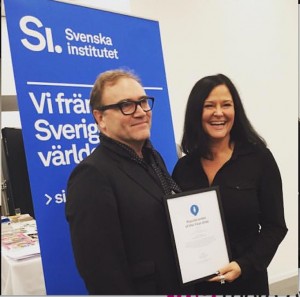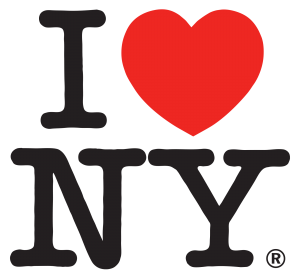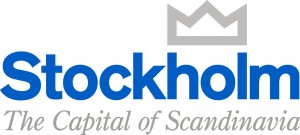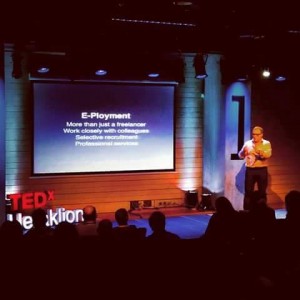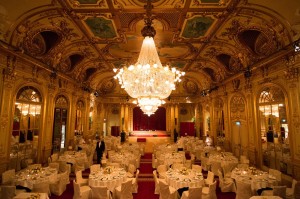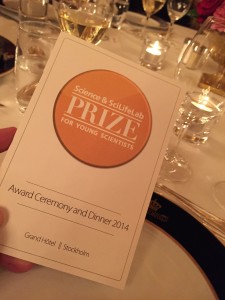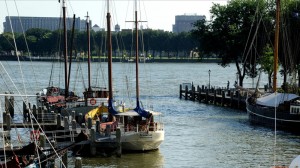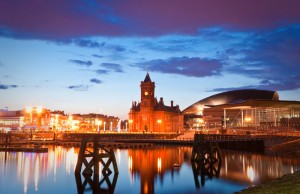The Science & SciLifeLab Prize for Young Scientists
- Dec 1, 2015
- Written by Julian Stubbs
- 0 Comments

Luleå wins Placebrander of the year
- Nov 18, 2015
- Written by Julian Stubbs
- 0 Comments
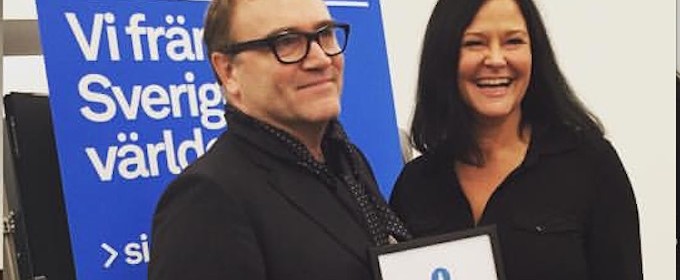
Public Speaking: Ten Things to Stop Doing
- May 28, 2015
- Written by Julian Stubbs
- 0 Comments
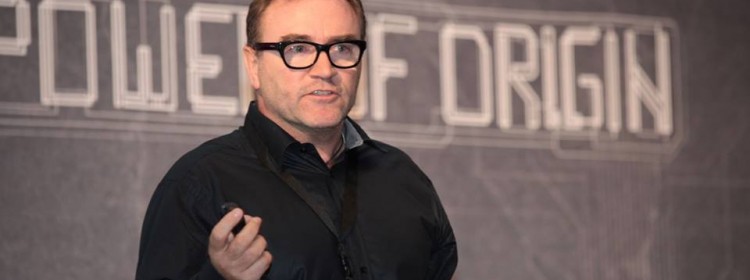
All of us at some point in life have to stand up in front of other people and make some sort of presentation. That’s just the way it is. Whether it’s only a verbal presentation to a few people or a Ted Talk with cameras and a larger audience, there are some simple things to remember that will help you make as strong a presentation as possible.
Ok, you’ve just been invited to make a presentation and the fear starts to set in. Well, don’t panic. According to my Myers-Briggs Type Indicator, I’m a 100% confirmed introvert, so not someone who naturally enjoys public speaking. However that doesn’t necessarily mean I can’t stand on a stage and give a speech—in fact I’ve done it hundreds of times and have survived, and so can you. The most important thing is to prepare correctly, practice and then stick to a few simple rules. These are the focus of this blog. They are the rules I’ve lived by and they seem to work for me.1. Don’t reach for a computer right away.
My first rule is don’t reach for the computer first. Plan in analog. Get a plain sheet of paper or better still, a large flip chart, and map out what you want to cover in your presentation. I’m a digital nut, but the computer can come out later as you start to build the actual slide deck.2. Don’t start with detail – start with an idea.
The most important part of any speech or presentation is an idea, not detail. Detail is there to support the idea and I see too many people who think that just simply presenting lots of data and facts makes for a great, engaging, presentation. It doesn’t. It starts with a good idea.3. Don’t focus on too many things. The rule of three.
A presentation is a story, so think of it that way. You are telling a story and like all good stories there is a beginning, a middle and an end. Build three parts to your presentation and start to decide how you will structure it into these three sections. Doing this makes it much easier for the audience to remember the salient points and helps them structure in their own minds what you are talking about.4. Don’t use bullets on slides (repeat this statement 10 times).
If there is one thing that puts me, or just about any audience to sleep rapidly, it’s slides covered in bullet points. You see people’s eyes glaze over as presenters show a long bulleted list of things they will be talking about. Too often presenters use a bullet point list to remind themselves of the points they are hoping to talk about, which really means the presenter is not well rehearsed enough. Humans don’t engage with bullet point lists. We engage with stories (more on this later). Instead, aim to make your slides visually interesting and appealing. Use single words or at most a phrase or single image on a slide to support what you are talking about and never just clutter your slides with ‘stuff’. Big simple words and images work best. One practice I always stick to is dissection. Once I think I have a presentation ready, I try to go through it again and take away even more words or images. Keep things simple,5. Don’t talk about what you want. Talk about what your audience wants.
Any good presenter knows that focusing on what the audience wants to get out of it is key. Always get advanced information about your audience, and put yourself in their shoes. Try to imagine what they want to get from your presentation and what is going to make it a great presentation from their point of view. There will be certain points you need to cover, so think about where you will cover these in the presentation, and the evidence and facts you have to support these points.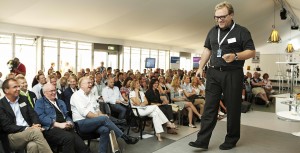
6. Don’t discombobulate (don’t use difficult words).
A common mistake I see in presentations is that people use overly complex or obscure language. It just confuses people. One way of getting an audience to remember your presentation is to use simple everyday language and powerful big numbers. Use fun and interesting words that add that extra punch. Too many business presenters hide behind complex terms and phrases, and this doesn’t help their presentation or get the audience to engage with it. When using numbers, keep it simple and add context so the audience can better understand what the numbers mean. I recently gave a Ted talk about the benefits of remote working and working from home, and wanted to talk about how much time I used to waste every day that I sat in a car. I didn’t just want to state the number of hours per day, which was 2 hours per day. I wanted to really communicate what that meant in context. So I talked about the 18 days a year I was wasting, which is equivalent to more than a two-week holiday. Give your numbers a human scale.7. Don’t just hope it will be all right on the day. Practice!
We all know that practice makes perfect, and this is never more true than when it comes to making a presentation. Once you’ve got your draft presentation ready, rehearse with yourself and talk it through. See if the words come out easily and where there are complexities you need to navigate. I tend to practice talking out loud and even time the presentation. Whenever I start practicing a new presentation, it sounds awful – but that’s why you practice! I then typically ‘rehearse’ parts of my presentation in conversation with friends to test out my arguments to see if they hold up under discussion. Finally, I run through the whole presentation with close friends, or my wife, who can give honest, critical, feedback. In the TedX speaker’s guide they list the most important elements in making a great Ted talk. And top of the list is rehearsal. So know your subject and rehearse, rehearse, rehearse. 8. Don’t just assume…check the technology. My biggest actual fear in making a presentation is technology not working. So I always check that the technology works. Confirm that the films play, slides animate correctly, and sound is working. Don’t just assume it will work. Have a run through: check the projector, and that the slides look good, check the sound system if you have one as well as any other technology like remote controls or pointers. And even once you have done all that, be prepared for disaster. I’ve been in those situations. Once I was giving a presentation in Phoenix, Arizona, to around 250 people and, despite there being two technicians present, the computer system crashed as I walked out on stage. (They were using a PC running PowerPoint. Since that day, I have always insisted on using my own Apple Macintosh computer running Keynote as the presentation program). But in spite of the technical issues, I managed to cope as I had prepared for a verbal version of the presentation using notes I’d written on cards – just in case. I keep the cards tucked away in my pocket as a final back up. So never assume everything will just work.9. Don’t keep looking at the slides, your finger nails or your laser pointer or anything else except the audience.
One of the worse nervous habits some people have is to stare out into space or at anything except the audience. One very senior executive I know has the habit of examining in detail the remote control in his hand to avoid making eye contact with the audience. So, look the audience in the eyes and don’t even look at your own slides. It will make you look awkward. Know you material well enough to make eye contact with your audience and engage them throughout. Even try to build in some two- way dialogue where possible with your audience.10. Finally – you don’t have a Boa constrictor wrapped around you. So breathe!
Boa constrictors kill their prey by wrapping around them and squeezing tighter every time their prey lets out a breath Some people, when they’re presenting, seem to have the same problem. So don’t forget to breathe! Before you walk on stage or stand up, take a couple of good deep breaths and compose yourself. When you are talking, take a moment every now and again and make sure you are not rushing. Slow things down – it’s not a race. Even when giving a Ted talk, and the 18-minute clock is counting down in front of you, remember to take pauses. It allows you to breath naturally. Pace is so important. Taking those pauses makes you look more in control and confident as a speaker, and lets you breathe. If it’s a larger audience, say over 200, try to pick out a few people around the room to use as focal points, covering all areas of the audience. It helps make you look more animated. So those are my personal ten important points to consider when giving a presentation. And remember, most people in the audience want you to give a great presentation – so they are sympathetic. Smile, be yourself and genuinely engage with them on a human level. They will appreciate it. Good luck!‘Open the window and stick your head out occasionally.’
- Apr 27, 2015
- Written by Julian Stubbs
- 0 Comments
Greece and the ‘C’ Word. TED Talk Greece
- Mar 5, 2015
- Written by Julian Stubbs
- 0 Comments
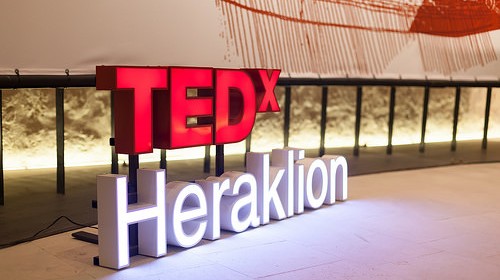
Crisis. Never waste a good one
So how could I not talk about the crisis? In fact, as a place marketing person, my talk will focus on the fact that most great cities and places need a decent crisis before they get their act together. The saying ‘Never waste a good crisis’ certainly comes to mind. War can certainly be deemed a crisis. But just look at what has come out of war. During the Second World War modern computing, an idea that had been kicking around since the 19th century with Charles Babbage and his difference engine, was developed on both sides of the Atlantic simultaneously. In the US, with their ENIAC computer, to aid complex artillery ranging calculations and also at Bletchley Park in England, with their Colossus computer, developed to help crack the German Enigma codes. Similarly, RADAR had been around as an idea for some time, but it took the crisis of the Second World War for British scientists to really turn it into a functioning technology. In fact, it was probably this very technology that helped Britain win the Battle of Britain in the air in the summer of 1940. We have RADAR to thank for the modern microwave as well, a technology that was discovered by accident when Percy Spencer, an American self-taught engineer, noticed that the chocolate bar he was carrying in his pocket had melted when he stood too close to the radar set he was working on. If all that isn’t enough, even FANTA, the fizzy orange drink, was developed out of crisis. After 1941, the Germans, understandably enough, were not able to get hold of the syrup they needed to make Coco-Cola. So the head of Coco-Cola Germany decided to create a new product, made out of what was available to them – oranges from North Africa. The name came about when they were brainstorming for the new product and the head of the company said they needed to use their imaginations more, or Fantasie, as it’s said in German. And so – FANTA was born.
Similarly, RADAR had been around as an idea for some time, but it took the crisis of the Second World War for British scientists to really turn it into a functioning technology. In fact, it was probably this very technology that helped Britain win the Battle of Britain in the air in the summer of 1940. We have RADAR to thank for the modern microwave as well, a technology that was discovered by accident when Percy Spencer, an American self-taught engineer, noticed that the chocolate bar he was carrying in his pocket had melted when he stood too close to the radar set he was working on. If all that isn’t enough, even FANTA, the fizzy orange drink, was developed out of crisis. After 1941, the Germans, understandably enough, were not able to get hold of the syrup they needed to make Coco-Cola. So the head of Coco-Cola Germany decided to create a new product, made out of what was available to them – oranges from North Africa. The name came about when they were brainstorming for the new product and the head of the company said they needed to use their imaginations more, or Fantasie, as it’s said in German. And so – FANTA was born.
Crisis and Places
Crisis has been central when it comes to Place Marketing as well. Take the example of New York in the 1970s. The city and state were gripped by recession and still feeling the effects of the oil crisis. New York State was in the depths of a severe financial downturn and the City of New York was on the verge of bankruptcy, with the Federal Government, under President Ford, refusing to bail out the city or state. New York had a host of problems, in particular a surging crime rate, which was driving away tourists. An action plan was urgently needed to generate revenue. They hit upon the idea to attract more tourists to the state and city by using a promotional campaign. The New York State Department of Commerce saw this as the quickest way to generate hard cash. That is when they developed the strategy of Market today, visitors tomorrow. They recruited Milton Glaser, a famous local graphic designer, to work with them on a campaign and to develop a slogan and approach for the state and city to rally around. Glaser’s idea was very simple and focused on the one thing about NY that was most unique to it – its people. Its people and their passion for New York. This passion made New York a very special place. Glaser developed the now iconic I love NY graphic and slogan. It was to become the most recognised, and copied, destination brand icon in the world. Similarly, when I was recruited to work on the Stockholm branding back in 2002-2003 the city had been through a severe crisis. The dotcom bubble had burst and the fall out was spectacularly affecting the stock market and the city, which had stopped growing for the first time in many years. After conducting our audit work, examining external research and running internal focus groups and workshops, we realised what the city needed most was a central focus. It needed a powerful new business proposition and an umbrella identity to work under. The primary target was tourism, and inward investment. We developed our napkin strategy (any good idea should be tight enough to be written on the back of a napkin) and declared Stockholm the most important place in Scandinavia for tourism and business. Based on our evidence, it was. Once this was signed off it was just a short creative step to the execution and positioning of Stockholm as The Capital of Scandinavia. So, inside the cloud of every crisis there can be a silver lining of an opportunity.Personal Crisis
Now we all hit the odd personal crisis now and again. I tend to have one every time Liverpool loses a football match. That aside, I hit a more severe personal crisis a few years back. I was working for a company and had two things in my life I really felt weren’t adding to the overall quality of my life or well-being, or even my productivity and work.The Boss
The first was having a boss. Now I’ve had a few bosses over the years and some have been very good and have actually helped me to develop as an individual. But there have been a few who have been lacking in this respect and, worse of all, were egocentric maniacs and control freaks. You really have to question the real function of a boss. In part, their job is managing processes but especially managing people. Added to that a major part of their focus tends to be measuring productivity – your productivity. Now it seems a bit of a waste of time in the 21st century to employ someone to look over someone else’s shoulder to check they aren’t slacking off. It suggests a certain lack of trust as well as the organisation in question lacking decent systems and processes to measure productivity and performance. So do we all need a boss? Some people might, but I just don’t happen to be one of them.Traffic
The other issue I had was concerning cars. Lots of cars in the form of traffic jams in the rush hour. I was sick of sitting in traffic jams on my way to the office. Yes, even in so-called utopian Sweden, we have traffic jams. I was sitting in traffic everyday and commuting for up to two hours. And we had over 50 people doing the same as me everyday. Was that productive? As Ian Dury would say, ‘what a waste.’ So one day, stuck in a traffic jam, burning fuel and belching out CO2, I started working out how much time I was actually wasting in my daily commute. The numbers were astonishing. Two hours per day, which was 10 hours per week, which when multiplied by my commute of 45 weeks a year was a mind-boggling 450 hours a year. That’s over 18 days each year. What could I do with 18 more days a year? (If you want to get really silly with these sort of numbers you can give yourself a few other shocks as well. We all know the one about someone with an average life expectancy spending 25 years of their life in bed sleeping. But less well known is that the average American will spend 1.9 years sat in front of the television and a mere 48 days during their entire lives having sex. I stress these are averages for typical Americans). Anyway, back to my 18 days a year and realisation that bosses could be a waste of space.1099 Economy. Over 50 Million Americans
So I quit. I decided to become independent. A freelancer. Now Americans talk about The 1099 Economy, named after the IRS tax code people fall into if they are self-employed. The US Freelancers Union claims that today fully 34% of the entire US workforce fall into the 1099 tax code. If accurate, that’s 53 million people. That’s a lot of people and it’s still growing. So I wasn’t alone. I started thinking about ways to use my 18 days a year. The first thought that sprang to mind was just lying in a hammock on a beach for a couple of weeks. That’d be better use of time than sitting in a traffic jam for sure. But it wouldn’t be very productive or valuable in the longer term. I was also starting to question the whole logic of traditional employment itself. It’s actually a very 19th century concept, and we all know nowadays, for a certain category of work, we don’t actually need to live close to the factory or office to be really productive. Being independent and working on my own had certain appeals. Flexibility was the most attractive thing. But there were downsides. Firstly, and most practically, earning money. I was normally OK on this front, so that was not my major concern. The bigger downside was that being ‘on my own’. I wouldn’t be able to compete as well when it came to larger jobs. Working alone, and I’d done this before, can also be a pretty lonely experience.The Hammock Theory
That’s how I hit on the idea of the Hammock Theory. The thing was, in my line of work, I could actually sit and work anywhere I liked. Including in a hammock, should I wish. (I have to stress, I’ve tried working in hammocks and it’s not all it’s cracked up to be. Personally I find it impossible and extremely difficult on the Wi-Fi and power charging front. In fact it’s largely a myth). But I could work from anywhere with the incredible tools now on offer through the cloud. Living and working from everywhere is now possible. There are great tools for communications like Facetime, Skype and Go To Meeting. Great tools for productivity like Basecamp and Team Gant. There are also incredible file back up and storage systems such as Drop Box. The cloud had once been a dream but it is now a reality and it actually works. I’d been using most of the cloud-based tools for years already, so moving further into the cloud was an easy step for me.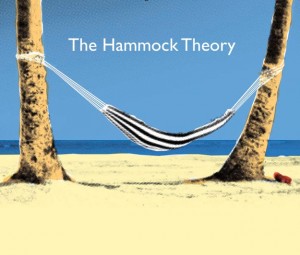 Now the On Demand Economy gets talked about a lot already these days, and people mostly mean the likes of Air BnB, Uber or Elance. These are big brands but not what I was personally after. I didn’t fancy renting out my room to a stranger. Equally I would make an awful taxi driver. I was looking for something more professionally focused. Elance has over a million people signed up, and obviously works for many people. But that didn’t deliver what I personally wanted. I was after something that would give me more than just an income. I wanted colleagues that I could work with closely, everyday, all around the world, just as in a regular company. People I’d interact with everyday. And an organisation that provided opportunities to grow and learn. I didn’t actually want to work for an organisation that would just sign up anybody. Instead, I wanted something much more selective in who was recruited, aimed at professionals like myself.
I knew plenty of people like me, very good people. What if we created an umbrella for us all to work under, in the cloud? We could create a brand and organisation to set a standard for the processes and systems we would jointly use. Working together we would be vastly more effective than working individually. And even with just the people I knew, like me, we could be global from day one.
That’s when, with a couple of close friends, we hit on the idea of UP THERE, EVERYWHERE. A global cloud based organisation, made for people who wanted to work together under one brand and with common tools. People who wanted to work globally and locally. People who would interact everyday if needed, just as in a regular company.
Anyone who wanted to join us would need to go through a number of interviews and be recommended, not for employment – because we would have no employees, but for membership.
Now the On Demand Economy gets talked about a lot already these days, and people mostly mean the likes of Air BnB, Uber or Elance. These are big brands but not what I was personally after. I didn’t fancy renting out my room to a stranger. Equally I would make an awful taxi driver. I was looking for something more professionally focused. Elance has over a million people signed up, and obviously works for many people. But that didn’t deliver what I personally wanted. I was after something that would give me more than just an income. I wanted colleagues that I could work with closely, everyday, all around the world, just as in a regular company. People I’d interact with everyday. And an organisation that provided opportunities to grow and learn. I didn’t actually want to work for an organisation that would just sign up anybody. Instead, I wanted something much more selective in who was recruited, aimed at professionals like myself.
I knew plenty of people like me, very good people. What if we created an umbrella for us all to work under, in the cloud? We could create a brand and organisation to set a standard for the processes and systems we would jointly use. Working together we would be vastly more effective than working individually. And even with just the people I knew, like me, we could be global from day one.
That’s when, with a couple of close friends, we hit on the idea of UP THERE, EVERYWHERE. A global cloud based organisation, made for people who wanted to work together under one brand and with common tools. People who wanted to work globally and locally. People who would interact everyday if needed, just as in a regular company.
Anyone who wanted to join us would need to go through a number of interviews and be recommended, not for employment – because we would have no employees, but for membership.
Opportunities: For Business, For People
We’ve been working this way in UP for more than three years now and I can tell you it works. In a very short space of time, we’ve created in an operation with sales of over three million dollars a year. It’s not always easy, but it works far better, and provides more flexibility, than the alternative. From a business opportunity perspective this way of working enables organisations to be totally global, to operate extremely effectively and allows them to be hyper competitive. It’s an idea whose time has come for the service industries. As an important aside, it’s also extremely good for the environment. I’m not sitting in a car so often and I don’t need to go to an office everyday, again wasting precious resources. It’s made for the world we live in. The opportunity for people is that it gives them the chance to hang their hammock wherever they want. Depending on each person’s personal situation and skill set, they can live and work wherever they want and still be totally connected to their team and clients. I live in Stockholm and , part from Sweden, work everyday with clients in Switzerland, England, Holland, California and more. And I do it with a team who works in the exact same way. Now that’s pretty cool, but more importantly it’s extremely effective. I’m certainly free of ‘the boss’ but the biggest benefit I see personally is the flexibility it gives me over my time and life. I can now schedule my work around the other important things in my life, like picking my son up from school and getting the chance to kick a football with him for an hour. Then I go right back to work. The biggest demand of working this way is self-responsibility. If you are truly going to make this work for you, you have to take self-responsibility to a new level. You need to have self-responsibility for your life, income, work and colleagues.Opportunity for Places
Finally there are huge opportunities for cities, municipalities and countries that are looking to attract this new breed of mobile creative class, or E-Ployees as we call them, who work in the cloud. Despite working in the cloud, these people still pay their taxes on the ground. Places like Heraklion and Greece could benefit enormously from attracting people like this. Places need to examine their assets and consider what it takes to attract this new breed of worker. Consider a place like Heraklion. They have a great diet, lower overall living costs than most places and a warm and sunny climate (as an aside, in Stockholm last November we achieved 4 hours of sunlight for the entire month. In Sweden in winter we have more than fifty shades of grey). But to make all this work, places need to make sure certain things are in place and easily available. There’s no such thing as a free lunch, even if it’s a feta and sardine salad. The first must have is free, high speed broadband. It’s the oxygen for E-Ployees. The other thing is great infrastructure or planes, trains and Teslas (if you get my drift). E-Ployees are a highly mobile bunch and move around their world a fair bit, both for work and leisure. Also important is a very low level of bureaucracy and corruption. That’s one of the benefits of living in a place like Sweden (in Sweden politicians are considered totally corrupt if they get caught a putting a Mars Bar on their expense account). We also seek tolerant, open societies with high levels of cultural attractiveness. Things like theatre, music, museums, coffee shops, restaurants and the opportunity to socialise easily together. Great ideas come out of those interactions and when you are working remotely in the cloud, you need those other social interactions even more. Additionally, a truly international environment is important. E-Ployees tend to be a global lot and feel most at home in international environments. We’re global citizens and we like living in places that reflect that. Finally, places need to make it easy for people to vote with their feet. Make moving to a city, municipality or country easy. Provide simple and straightforward information on the ins and outs of moving to a place, provide help and keep it as simple as possible. I think we live in an exciting time. We’ve had the agricultural revolution, the industrial revolution and more recently the technological revolution. All affected the way we live and where we live. We believe there is a new revolution about to happen. We no longer need to live close to the factory or office. We no longer need to work in organisations and companies designed for the 19th century. For employees and freelancers seeking a better, closer, way of working we believe they will find it through the cloud and by working together in close organised communities. Where will you hang your hammock? Julian Stubbs is Founder and CEO of UP THERE, EVERYWHERE, The Global Cloud Based Agency. His book E-Ployment: Living & Working in the Cloud is available on Amazon.Quote from Julian Stubbs
‘We’ve been working this way for more than three years now. We’ve put in place the processes and systems to make this way of working through the cloud possible. We’ve gone from two individuals to 200 people working under one global brand and organisation: UP THERE, EVERYWHERE. Within the next couple of years we estimate we’ll be somewhere around 500 to 600 people. People who can decide more than ever before where they want to live’.TedX Heraklion
This blog is based on the TED talk by Julian Stubbs, given in Heraklion, Greece, February 28th 2015. The film will be available on the TED channel in late March 2015.A Seasonal Tale of a Louis Vuitton Bag and Just a Little Too Much Pernod Perhaps…
- Dec 19, 2014
- Written by Julian Stubbs
- 0 Comments
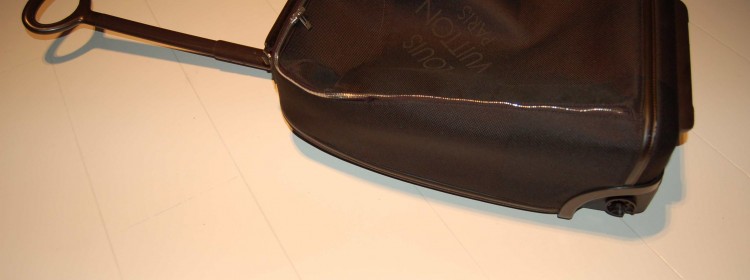
Doom & Gloom. But a Glimmer of Light on a Dark Swedish Night
- Dec 12, 2014
- Written by Julian Stubbs
- 0 Comments
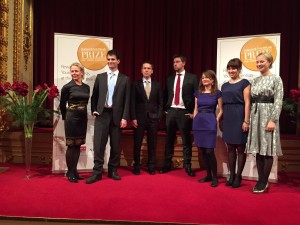
Picture shows from left to right Anne Burrows (Senior Account Director UP), winners Liron Bar-Peled, Dan Dominissini, Simon Johnson, Chelsea Wood, Jenny Aarnio (Account Manager at UP) and Susanna Appel (SciLifeLab).
Place Branding: Roffa Rising
- Dec 4, 2014
- Written by Julian Stubbs
- 0 Comments
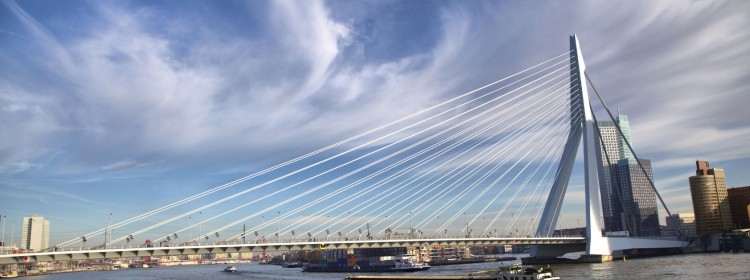
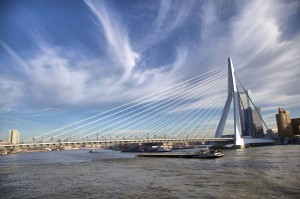
Cardiff? Definitely not Lagom
- Nov 23, 2014
- Written by Julian Stubbs
- 0 Comments
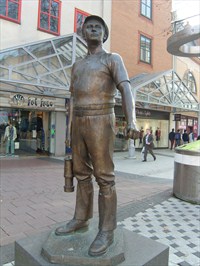
The Miner by local sculptor Robert Thomas, is a reminder of the sweat and blood that the city of Cardiff is built upon. It makes the point wonderfully well of how very different, and comparatively easy, our modern day life is.
Tim Williams CEO of The Committee for Sydney
Another key participant at the Capital City Vision Event, was Tim Williams – CEO of The Committee for Sydney. Tim, a proud Welshman, was formerly CEO of the Thames Gateway London Partnership where he made the Gateway in East London the key urban regeneration project for London and indeed the UK. Tim is recognised as one of the leading urban renewal thinkers and practitioners at work in the field, with an international reputation.
Tim’s brilliant speech focused on the future of cities. People are flocking to cities and most interestingly back to city centres. The dream of our parents and grand parents of living in suburbia is in full reverse. Thirty years ago inner cities had connotations of being dangerous, low quality slum districts but today more and more people want to live in the heart of cities. The easy access to amenities, connectivity and being able to conduct daily life in a simpler, lower cost way are some of the major drivers. These new urbanites offer many benefits to society as well, such as reduced carbon footprint as daily commutes are impacted and with people living in smaller city centre accommodation.
Bright Flight
These people are educated and seeking knowledge based jobs as well. This phenomenon is what the demographer William Frey has in mind when he says “A new image of urban America is in the making. What used to be white flight to the suburbs is turning into ‘bright flight’ to cities that have become magnets for aspiring young adults who see access to knowledge-based jobs, public transportation and a new city ambiance as an attraction.”
The point is to ensure you have some of what attracts ‘bright flight’: walkable urbanism.And it’s not just the young. Interestingly the baby boomers, who are now approaching retirement age, are seeking easier, lower cost, life styles with their larger homes in the suburbs now costing them more time and effort to maintain and heat. City centre living also reduces the need for cars. This means cities need efficient, good quality, public transportation systems as well as offering walkable urbanism.
Place Branding: The Drivers and Issues
My own speech in Cardiff focused on three aspects of developing a strong city brand. Firstly I looked at some of the drivers for city branding such as the attraction of tourists, inward investment as well as new tax paying residents. Place and city branding is one of the most complex marketing tasks that can be undertaken and has to involve a high degree of stakeholder contact. Identifying and involving the key stakeholders is central to any place branding strategy. Finally I looked at positioning, which goes to the very heart of place branding. Here I referenced my own work for the city of Stockholm and its positioning as The Capital of Scandinavia. The art of marketing is the art of branding. The art of branding is the art of positioning. What do you stand for and represent? I play a little game of asking people what one word they would use to describe a city. It’s one of the most challenging questions to answer for any brand and goes to the heart of positioning.
Place branding has grown enormously in the last ten years and as one place markets itself, very other place has to. Many of the disciplines of consumer marketing apply however to place branding. Like a traditional brand, places need to develop long term strategies. These should have a ten and twenty year perspective and not change with every political cycle. This means politicians need to be engaged early on and the strategy needs to have cross political party agreement to have a long term future. Stockholm’s has been in place now over ten years and has been through different political administrations successfully.
Building strong place brands can have a remarkable impact on cities. Just take the case of Barcelona. Today it is seen as one of the world’s most successful cities. However, it was all very different forty years ago. In the 1975 series Fawlty Towers Manuel, the hapless Spanish waiter who lived in fear of Mr Fawlty, was cast as coming from Barcelona. His home town was chosen with great care – as at that stage Barcelona was considered by many foreigners to be a run down, dirty, industrial black hole. It wasn’t until the death of Franco in 1975, that a new regional focus was put in place to get the city back on a path to regeneration. One of the key springboards in the strategy was the winning, and hugely successful staging of, the 1992 Olympic games, Barcelona is one of the few destinations to have run an Olympics at a profit. More than most places, the case of Barcelona proves that it is possible to turn around the fortunes of a city given the right strategy, a high degree of stakeholder involvement, focus and – most importantly – investment.
The Barcelona case was I felt relevant to my Cardiff presentation. Cardiff has been through a remarkable transformation since my youth. It’s already impressive. But the UK needs to embrace a more decentralised approach. London still dominates but turning the UK’s regional cities into new economic power houses would have tremendous benefits for the entire UK economy.
I was asked what one word I would use to describe Cardiff and spontaneously I replied passion. It’s a city with genuine passion and pride. You can feel it in meeting the local people and politicians. Lagom? Certainly not. Cardiff is a place that deserves to succeed and stand out. As the Capital city of Wales it also has a gravitas that most cities can’t match.
Cardiff has yet more potential to offer and I believe the best is yet to come. Granny Stubbs, my Welsh grandmother, would be proud.
—————————————————————– Watch an extract from the Capital City Vision speech here:3 Lessons in Place Branding Excellence
- Oct 11, 2014
- Written by Julian Stubbs
- 0 Comments
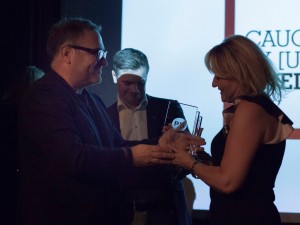 It was interesting in reviewing the various entries from around Sweden and to reflect on what made for an outstanding entry.
The official criteria, which are extremely valid, were a Place Branding project that led to the growth of the destination in terms of tourism, inward investment, residential growth or an increase in activity such as congresses and exhibitions.
The three things I look for
But what more was I looking for as a judge? What else was important to see that went beyond these initial worthy criteria?
1. One of the striking things is that too many place branding activities are ‘campaign focused’. Campaigns in my mind tend to be too short term. Places are difficult things to market and create strong brands for. Branding takes time and a campaign tends to be a shorter term, one off, event. I think part of the issue is that traditional advertising agencies themselves are very campaign oriented. Traditional advertising agencies aren’t terribly good at dealing with the greater complexity that Place Branding really demands.
Equally the place or destination itself needs to clearly identify goals with definable long term strategic objectives. What is the place trying to achieve? What are their goals in terms of either inward investment, tourism or residential growth. Too often these are missing and even when present, tend to be expressed in generalities. Each place is different and demands a different, long term, set of objectives.
2. Once these longer term goals and objectives are identified the focus should be on creating a really distinct positioning. The art of marketing is the art of branding. The art of branding is the creation of a distinct positioning. Being number one in your chosen category. It is the hardest thing to get right. We did it wonderfully well with the work we did for Stockholm – as The Capital of Scandinavia. A simple and clear proposition. A distinct positioning means being just that – distinct. You can’t be all things to all people. You need to stand for something and that will probably lead to some people not liking it. But if you produce wallpaper that doesn’t stand out, odds are you won’t offend anyone- but equally you won’t stand out either.
3. Communications that really communicates. Beyond the branding elements I obviously look at the communications thinking and increasingly a good mix between traditional media and activities and social media use. I think nearly all places and destinations engage in some form of social media activity nowadays, but unfortunately too much of it is disjointed and sporadic. The world of marketing has been turned on its head in the last ten years and nowadays customers are in control of what they want to see and experience. They can get more information, and form opinions about places, and brands, without ever looking at your website or following your social media posts. The whole focus nowadays should be built around attracting the right customers to seek you out and the way you do that is with great quality Content and strong Inbound Marketing programmes. If you are not using this approach in your marketing yet, odds are you are producing lots of content but it is probably being wasted, and measurement of results is not being utilised to refine messaging and campaigns. The key is creating great quality content, without it being overly sales oriented. It firstly needs to be great quality content on a topic. Approach it as you would a relationship with a person. On the first date you don’t normally offer to get married and have kids. You get to know each other and gently build the relationship. It’s like that with marketing and especially content and inbound.
If you have not yet started thinking about Inbound, give us a call or visit the Inbound page on the UP THERE, EVERYWHERE website. We have teams of Inbound experts globally who can advise and help.
www.upthereeverywhere.com/inbound-marketing-services/
It was interesting in reviewing the various entries from around Sweden and to reflect on what made for an outstanding entry.
The official criteria, which are extremely valid, were a Place Branding project that led to the growth of the destination in terms of tourism, inward investment, residential growth or an increase in activity such as congresses and exhibitions.
The three things I look for
But what more was I looking for as a judge? What else was important to see that went beyond these initial worthy criteria?
1. One of the striking things is that too many place branding activities are ‘campaign focused’. Campaigns in my mind tend to be too short term. Places are difficult things to market and create strong brands for. Branding takes time and a campaign tends to be a shorter term, one off, event. I think part of the issue is that traditional advertising agencies themselves are very campaign oriented. Traditional advertising agencies aren’t terribly good at dealing with the greater complexity that Place Branding really demands.
Equally the place or destination itself needs to clearly identify goals with definable long term strategic objectives. What is the place trying to achieve? What are their goals in terms of either inward investment, tourism or residential growth. Too often these are missing and even when present, tend to be expressed in generalities. Each place is different and demands a different, long term, set of objectives.
2. Once these longer term goals and objectives are identified the focus should be on creating a really distinct positioning. The art of marketing is the art of branding. The art of branding is the creation of a distinct positioning. Being number one in your chosen category. It is the hardest thing to get right. We did it wonderfully well with the work we did for Stockholm – as The Capital of Scandinavia. A simple and clear proposition. A distinct positioning means being just that – distinct. You can’t be all things to all people. You need to stand for something and that will probably lead to some people not liking it. But if you produce wallpaper that doesn’t stand out, odds are you won’t offend anyone- but equally you won’t stand out either.
3. Communications that really communicates. Beyond the branding elements I obviously look at the communications thinking and increasingly a good mix between traditional media and activities and social media use. I think nearly all places and destinations engage in some form of social media activity nowadays, but unfortunately too much of it is disjointed and sporadic. The world of marketing has been turned on its head in the last ten years and nowadays customers are in control of what they want to see and experience. They can get more information, and form opinions about places, and brands, without ever looking at your website or following your social media posts. The whole focus nowadays should be built around attracting the right customers to seek you out and the way you do that is with great quality Content and strong Inbound Marketing programmes. If you are not using this approach in your marketing yet, odds are you are producing lots of content but it is probably being wasted, and measurement of results is not being utilised to refine messaging and campaigns. The key is creating great quality content, without it being overly sales oriented. It firstly needs to be great quality content on a topic. Approach it as you would a relationship with a person. On the first date you don’t normally offer to get married and have kids. You get to know each other and gently build the relationship. It’s like that with marketing and especially content and inbound.
If you have not yet started thinking about Inbound, give us a call or visit the Inbound page on the UP THERE, EVERYWHERE website. We have teams of Inbound experts globally who can advise and help.
www.upthereeverywhere.com/inbound-marketing-services/
